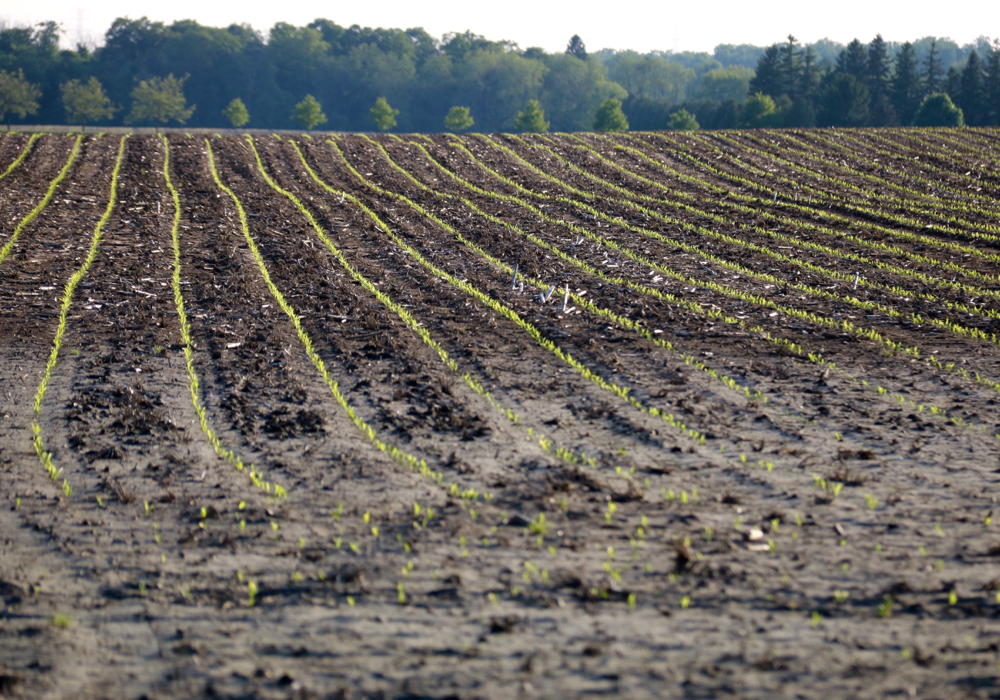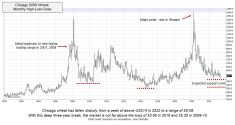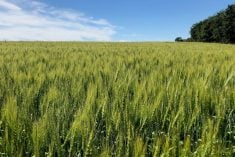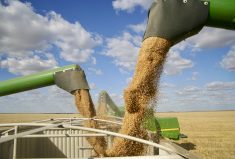Ontario has received 115 per cent to 150 per cent of normal precipitation over the past 30 days; rainfall in the northern counties has been greater than 150 per cent of normal. Despite the excessive moisture, a four to five-day window during the middle of June allowed Ontario farmers to make significant planting progress.
We believe 85 per cent of the Ontario corn and 80 per cent of the Ontario soybeans were seeded as of June 16. There is a high probability that 10 per cent to 15 per cent of the Ontario cropland will not be planted this year but farmers are going above and beyond to plant as much as possible. The Ontario winter wheat crop continues to deteriorate due to adverse rains and fusarium will be a major issue this year.
Read Also

Have the wheat bear markets run their course?
Wheat futures keep trying to rally. Time after time, the rallies fail. The markets seem stuck in low-level ruts.
The USDA WASDE report was considered bullish for corn and neutral for soybeans. Grain and oilseed markets continue to incorporate a risk premium due to the uncertainty in production. As of June 16, U.S. farmers had seeded 77 per cent of the soybean crop and 92 per cent of the expected corn area. The corn crop was rated 59 per cent good to excellent as of June 16, which compares to 78 per cent last year. The five to seven-day forecast across the U.S. Midwest calls for two to four inches of rain with the peripheral regions receiving one to three inches of precipitation.
The June Canadian dollar closed at 74.55 cents U.S. on June 17 which is relatively unchanged from two weeks ago. Investor sentiment has eroded in Canada due to Western alienation and media outlets hyping up Alberta separatism. Federal Bills C-48 and C-69 will temper economic growth longer term for the resource-based economy. Currency markets tend to incorporate a risk discount prior to an election, especially if left-leaning governments are ahead in the polls.
The average U.S. corn yield during the 2012/13 crop year was 123.4 bushels per acre, down from the current trend yield around 176 bushels per acre. Farmers may remember the spring and summer of 2012 was very dry. The corn futures peaked on Aug. 6, 2012 and then trended lower for the remainder of 2012 and throughout 2013. We refer to this history lesson so that farmers don’t become bullish on prices longer term. Traders usually underestimate yields during the growing season and the speculative funds drive the market to extreme highs. Once the Ontario corn and soybean crops are more certain, we’ll be more aggressive on sales.
Quick look
Soybeans: U.S. soybean carryout is likely to be a record in 2019, which will be a factor in prices.
Corn: A low carryout number for U.S. corn will be supportive of prices over the five-year average.
Soybeans
Despite the adverse conditions, we’ve increased our Ontario soybean production estimate. Ideas are that farmers will plant soybeans on some of the land that was initially going to be seeded to corn. Secondly, it’s too early to downgrade yield potential so we’re using average to trend type yields. We’re estimating the Ontario soybean crop to finish near 4.1 million tonnes, which is up from our earlier estimate of 3.7 million tonnes and slightly lower than last year’s crop size of 4.2 million tonnes.
On their June WASDE report, the USDA left their soybean acreage and yield projection unchanged from May. U.S. soybean production is expected to finish near 113 million tonnes, down marginally from the 2018 output of 124 million tonnes. It’s important to realize the U.S. soybean carryout will reach up to 29 million tonnes for the 2018/19 crop year, which is a record. For 2019/20, the carryout will be of similar size due to the year-over-year decline in exports.
What to do: Ontario elevator bids for old soybeans are hovering around $11.50/bushel while new crop soybean prices are in the range of $$11.55/bushel to $11.65/bushel. Prices are up approximately $0.50/bushel from early June. In this issue, we’re advising producers to finish old crop sales. At the same time, use this rally in the market to catch up to our new crop sales recommendation which is 30 per cent sold. The soybean market will function to encourage demand through lower prices under the current fundamental structure.
Corn
Corn is more susceptible to the later seeding dates than soybeans and therefore, we’ve lowered our Ontario corn production estimate. We’re now expecting average corn yields to come in around 150 bushels per acre, down from our earlier estimate of 160 bushels per acre. We’ve also made a downward revision to our seeded acreage. We’re now estimating Ontario corn production to finish near 7.4 million tonnes, down from our earlier May estimate of 8.8 million tonnes and down from last year’s output of 8.8 million tonnes. This lower production comes on the heels of a very tight carryout from the 2018/19 crop year.
In the June WASDE report, the USDA lowered its seeded area by 2.9 million acres from May and they also lowered their expected yield by 10 bushels per acre. U.S. corn production is now projected to come in at 347 million tonnes, down from the May estimate of 382 million tonnes and down from the 2018 crop size of 366 million tonnes.
The USDA lowered its demand projection as the higher prices will encourage more wheat feeding. Exports will also experience a year-over-year decline due to the lower crop size and larger output from South America. The U.S. carryout for 2019/20 is expected to finish near 43 million tonnes, down from the 2018/19 ending stocks of 56 million tonnes and down from the five-year average ending stocks of 46.4 million tonnes. Very simply, if the carryout is below the five-year average, prices will likely trade above the five-year average.
Markets don’t go straight up. Secondly, we’ve seen massive speculative fund buying over the past three weeks. Markets usually experience a correction through time by trading sideways or through price by experiencing a pullback.
What to do: Ontario elevator bids are near $6/bushel for old crop while new crop prices are quoted from $5.70/bushel to $5.90/bushel. The cash market is at an inverse. This is telling the farmer not to store old crop into new crop positions. Listen to the market. We’re advising producers to finish old crop sales. Use this rally to catch up to our new crop sales recommendation of 20 per cent sold.
Wheat
We continue to hear discouraging reports regarding the quality of the Ontario winter wheat crop. Average yields are expected but fusarium and other diseases are plaguing much of the wheat area. Our contacts continue to rate the crop 35 per cent poor to very poor, 40 per cent fair and 25 per cent good to excellent.
Despite the poor quality, prices are percolating higher due to the year-over-year decrease in U.S. corn production. Without going into detail, we believe that there will be significant volume of U.S. hard red winter wheat trading into feed channels during the 2019/20 crop year. This will cause the ending stocks for U.S. hard red winter wheat to come in below the five-year average. At the time of writing this article, the December Kansas wheat futures were trading at a $0.50/bushel premium to December corn.
Over the winter, we’ll likely see Kansas wheat futures trade at a discount to the corn futures because of the tight U.S. corn supplies. We’ve mentioned in previous issues that the U.S. soft red winter wheat fundamentals have potential to be very tight for the 2019/20 crop year due to the lower seeded acreage.
U.S. and Canadian spring wheat will dominate the milling market for 2019/20. Recent rains have enhanced yield prospects. We could see the Chicago wheat futures trade at a premium to the Minneapolis wheat futures. North American soft red winter wheat fundamentals are very tight but hard red spring wheat supplies will be burdensome for 2019/20. Without going into detail, analysts are expecting the second largest Russian wheat crop on record. Ukraine and Europe are also in good shape. We’re going to see Russian and Ukraine wheat trade into Mexico and Central and South America this crop year thereby limiting export demand for Canadian and U.S. spring and winter wheats.
What to do: In Ontario, old crop prices for soft red winter, hard red winter and hard red spring wheat are at the same price or premium to new crop. The market is telling farmers to sell now and not store into new crop positions. Therefore, we’re advising producers to finish old crop sales. We’ll start new crop sales once the quality and yields are more certain.















